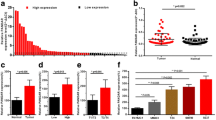Abstract
Stage Ta/T1 urothelial carcinoma of the bladder (Ta/T1 BC) has a marked tendency to recurrence. Long noncoding RNA HOTAIR has been reported to be expressed in some human cancers such as breast cancer, and it may be positively correlated with patient’s prognosis. The aim of our study was to evaluate the prognostic value of HOTAIR in Ta/T1 BC. HOTAIR expression in Ta/T1 BC tissues and adjacent normal tissues was collected from 110 patients and measured by real-time quantitative PCR. The relationships between HOTAIR and the clinical pathological characteristics of Ta/T1 BC patients were analyzed. Immunohistochemistry was done to detect the protein of Wnt inhibitory factor 1 (WIF-1) as well. Ninety out of 110 specimens were detected in HOTAIR high expression. Histological grade and expression levels of HOTAIR were positively correlated with the recurrence rate. HOTAIR expression (hazard ratio 4.712; 95 % CI 2.894–8.714; P < 0.001) was an independent predictor of recurrence rate in multivariate Cox regression analysis. HOTAIR expression is correlated with patients’ poor prognosis. A significant inverse correlation between HOTAIR and WIF-1 expression was demonstrated in Ta/T1 BC tissues. The expression levels of HOTAIR are an independent prognostic factor of recurrence in Ta/T1 BC patients.




Similar content being viewed by others
References
Siegel R, Naishadham D, Jemal A. Cancer statistics, 2013. CA Cancer J Clin. 2013;63:11–30.
Heney NM, Ahmed S, Flanagan MJ, et al. Superficial bladder cancer: progression and recurrence. J Urol. 1983;130:1083–6.
Stein JP, Lieskovsky G, Cote R, Groshen S, Feng AC, Boyd S, et al. Radical cystectomy in the treatment of invasive bladder cancer: long-term results in 1,054 patients. J Clin Oncol. 2001;19:666–75.
Stenzl A, Cowan NC, De Santis M, et al. Treatment of muscle-invasive and metastatic bladder cancer: update of the EAU guidelines[J]. Eur Urol. 2011;59(6):1009–18.
Lee JT. Lessons from X-chromosome inactivation: long ncRNA as guides and tethers to the epigenome. Genes Dev. 2009;23:1831–42.
Hung T, Chang HY. Long noncoding RNA in genome regulation: prospects and mechanisms. RNA Biol. 2010;7:582–5.
Cheetham SW, Gruhl F, Mattick JS, Dinger ME. Long noncoding RNAs and the genetics of cancer. Br J Cancer. 2013;108:2419–25.
Li CH, Chen Y. Targeting long non-coding RNAs in cancers: progress and prospects. Int J Biochem Cell Biol. 2013;45:1895–910.
Kogo R, Shimamura T, Mimori K, et al. Long noncoding RNA HOTAIR regulates polycomb-dependent chromatin modification and is associated with poor prognosis in colorectal cancers[J]. Cancer Res. 2011;71(20):6320–6.
Gupta RA, Shah N, Wang KC, et al. Long non-coding RNA HOTAIR reprograms chromatin state to promote cancer metastasis[J]. Nature. 2010;464(7291):1071–6.
Yang Z, Zhou L, Wu LM, et al. Overexpression of long non-coding RNA HOTAIR predicts tumor recurrence in hepatocellular carcinoma patients following liver transplantation[J]. Ann Surg Oncol. 2011;18(5):1243–50.
Niinuma T, Suzuki H, Nojima M, et al. Upregulation of miR-196a and HOTAIR drive malignant character in gastrointestinal stromal tumors. Cancer Res. 2012;72:1126–36.
Wang J, Sinha T, Wynshaw-Boris A. Wnt signaling in mammalian development: lessons from mouse genetics. Cold Spring Harb Perspect Biol. 2012;4.
Yang SH, Li SL, Dong ZM, Kan QC. Epigenetic inactivation of Wnt inhibitory factor-1 in human esophageal squamous cell carcinoma. Oncol Res. 2012;20:123–30.
Pez F, Lopez A, Kim M, Wands JR, Caron de Fromentel C, Merle P. Wnt signaling and hepatocarcinogenesis: molecular targets for the development of innovative anticancer drugs. J Hepatol. 2013;59:1107–17.
Sobin LH, Fleming ID. TNM classification of malignant tumors. Cancer. 1997;80:1803–4.
Mostofi FK, Davis CJ, Sesterhenn IA, Sobin LH. Histological typing of urinary bladder tumours. Berlin: Springer; 1999.
Ge XS, Ma HJ, Zheng XH, et al. HOTAIR, a prognostic factor in esophageal squamous cell carcinoma, inhibits WIF-1 expression and activates Wnt pathway. Cancer Sci. 2013;104:1675–82.
Liu XH, Liu ZL, Sun M, Liu J, Wang ZX, De W. The long non-coding RNA HOTAIR indicates a poor prognosis and promotes metastasis in non-small cell lung cancer. BMC Cancer. 2013;13:464.
Endo H, Shiroki T, Nakagawa T, et al. Enhanced expression of long non-coding RNA HOTAIR is associated with the development of gastric cancer. PLoS One. 2013;8:e77070.
Kaneko S, Li G, Son J, et al. Phosphorylation of the PRC2 component Ezh2 is cell cycle-regulated and up-regulates its binding to ncRNA. Genes Dev. 2010;24:2615–20.
Wang L, Zeng X, Chen S, et al. BRCA1 is a negative modulator of the PRC2 complex. EMBO J. 2013;32:1584–97.
Rubin EM, Guo Y, Tu K, Xie J, Zi X, Hoang BH. Wnt inhibitory factor 1 decreases tumorigenesis and metastasis in osteosarcoma. Mol Cancer Ther. 2010;9:731–41.
Acknowledgments
This work was supported by grants from the Foundation of Longyan Medical Science and Technique Key Program (No. 2013LY57).
Conflicts of interest
None
Author information
Authors and Affiliations
Corresponding author
Rights and permissions
About this article
Cite this article
Yan, TH., Lu, SW., Huang, YQ. et al. Upregulation of the long noncoding RNA HOTAIR predicts recurrence in stage Ta/T1 bladder cancer. Tumor Biol. 35, 10249–10257 (2014). https://doi.org/10.1007/s13277-014-2344-8
Received:
Accepted:
Published:
Issue Date:
DOI: https://doi.org/10.1007/s13277-014-2344-8




